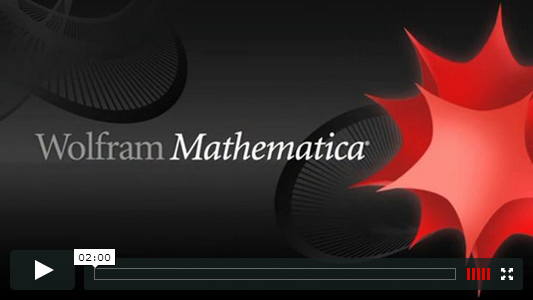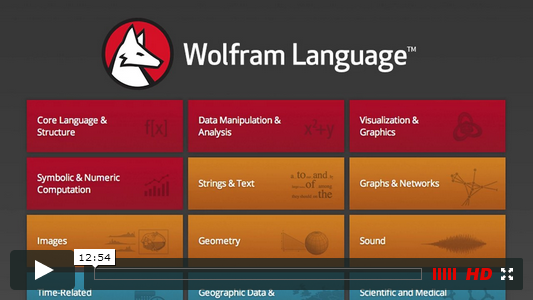
Wolfram Mathematica
Compute • Develop • Deploy
Mathematica is the integrated system for the complete development, computation, simulation, analysis, and documentation of technical problems in a unified, platform-independent working environment using Wolfram Language. With the revolutionary "one-click" runtime creation for passing on results with the Wolfram CDF Player's technology – an unequalled simple workflow – Mathematica is the ideal technical development environment using automated runtime creation. Mathematica integrates parallelised technologies to use multicore PCs or GPUs to full capacity and enables the generation of C code.
Mathematica provides the user with an almost infinite variety of mathematical functions to solve tasks from the fields of engineering, finance and insurance mathematics, mathematics, statistics, physics, "chemical computing" and, of course, all natural sciences. Additionally, it is possible to extend Mathematica's "knowledge" at will.
The user interacts with Mathematica via its intuitive user interface, the Notebook interface, that provides a clear and structured presentation of texts, formulas, models and simulations and even dynamic objects in an interface.

Wolfram is pioneering highly automated machine learning deeply integrated into the Wolfram Language. The machine learning algorithms allow automated merging of neural networks in unprecedented amorphous learning structures. The range of applicability is not limited to specific domains. Due to the multicore support, even extremely large networks can be computed in this way, because Mathematica knows no memory limits.
The extensive algorithms for 2D and 3D image analysis, including 3D volume rendering, allow for in-depth insights into complex images and geometries. Using a 3D printer, users can print 3D elements true to the model with the 3D printing feature.
By means of filters and special effects users can perform a more detailed analysis of audio and speech data. They can also synthetize any data, overlayed by filters and special effects.
For the field of linguistics and the associated speech analysis, the developers integrated a pool of functions to enable even the most complex text/string research. Some virtual assistants use these functions for live analysis and presentation of results. In computer linguistics, users can automate the visualization of, e.g., word clouds, grammar trees and, also, constituent trees.
Geodata in computations, analyses and visualizations is easy to handle for Mathematica, because it is nothing else than computable knowledge. Therefore, Mathematica is the ideal tool for the wide field of geomapping, which is connecting data with digital maps.
Especially for the area of new technologies like blockchain and also cryptocurrencies, the developers have developed their own algorithms that allow to deal with these things as well as to process and further process the extensive information. Data can be easily extracted and computable information can be used for a wide range of applications such as analytics, statistics, data mining, machine learning and education. Wolfram Language is one of the leading blockchain technologies due to its built-in natural language and knowledge base capabilities.
Wolfram maintains its own blockchain lab.
Another expert area in Mathematica is biology and medicine related entities. Mathematica offers an extensive collection of computable knowledge in the fileds of biology and medicine. The data covers a variety of areas - from human and animal anatomy to species taxonomy, genes, mutations and diseases. Built-in Wolfram Language capabilities can be used to analyze and visualize key features of biological systems, inlcuding the structural and functional organizations of living organisms. Biomedical capabilities extend into the construction and analysis of biosequences (DNA, circular DNA, RNA, and peptides).
Mathematica is the system for everything containing computable knowledge and allows for passing on this knowledge for free via CDF technology.
Core Technologies
-
Wolfram Language
The knowledge-based symbolic language that grew out of Mathematica, and now powers the Mathematica system. -
Functions & Algorithms
Mathematica offers an almost infinte amount of algorithms and functions covering the most different areas. -
Wolfram Knowledgebase – integriertes Wissen
The broad, continuously updated knowledgebase that powers Wolfram|Alpha and supplies computable real-world data for use in Wolfram products. -
Compute As You Think Technologie
Plain English can be used as input, based on Wolfram|Alpha. -
Wolfram Predictive Interface
The Wolfram Predictive Interface offers the user predictive suggestions and is based on the analysis of millions of queries to Wolfram|Alpha. -
Notebook Concept
The flexible document-based interface that lets you mix executable code, richly formatted text, dynamic graphics, and interactive interfaces in Mathematica. -
Universal Deployment
Deploy knowledge with dynamic content with one click, without programming or complex deployment routines. With Mathematica you create computations - Compute - and the - Develop - a Mathematica Knowledge App with one click to - Deploy - them via Wolfram Player family. -
Wolfram Cloud
Mathematica can be connected to the Wolfram Cloud, to Mathematica Online or to many other Wolfram Cloud products. There is no simpler way to share computations.


